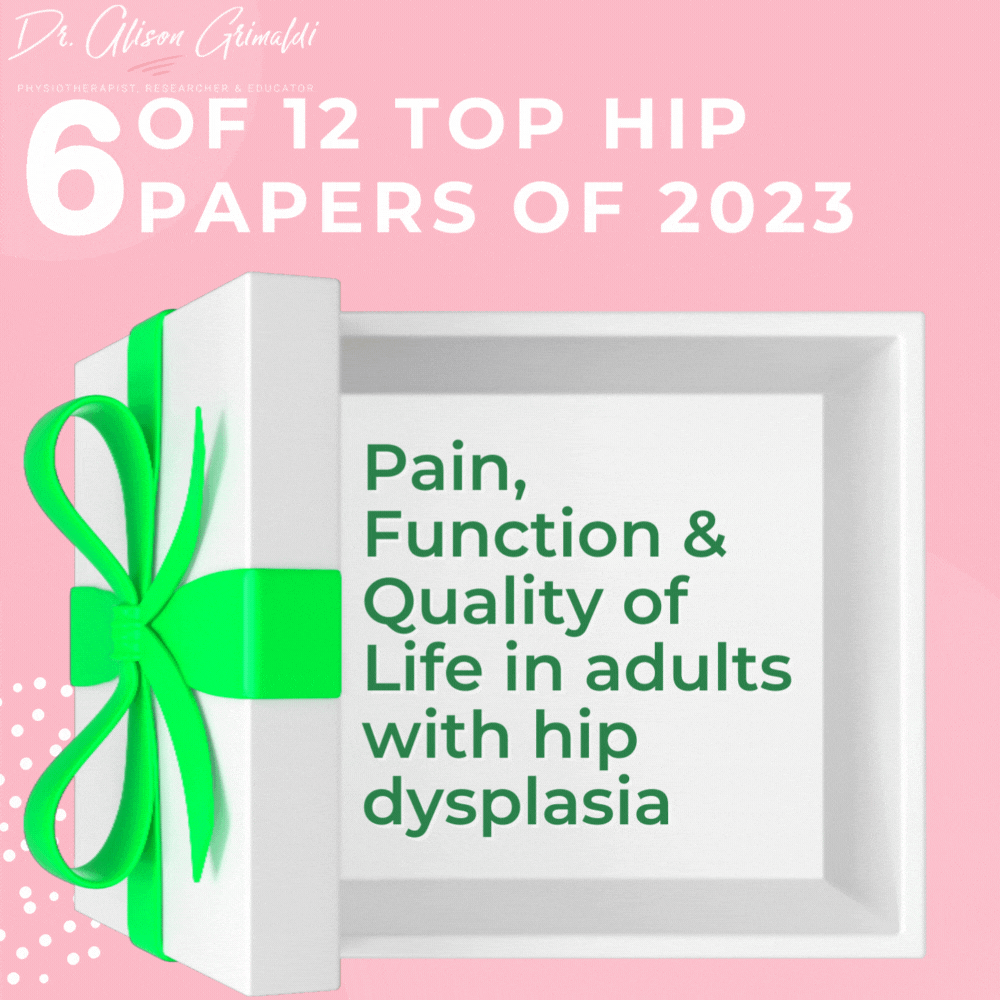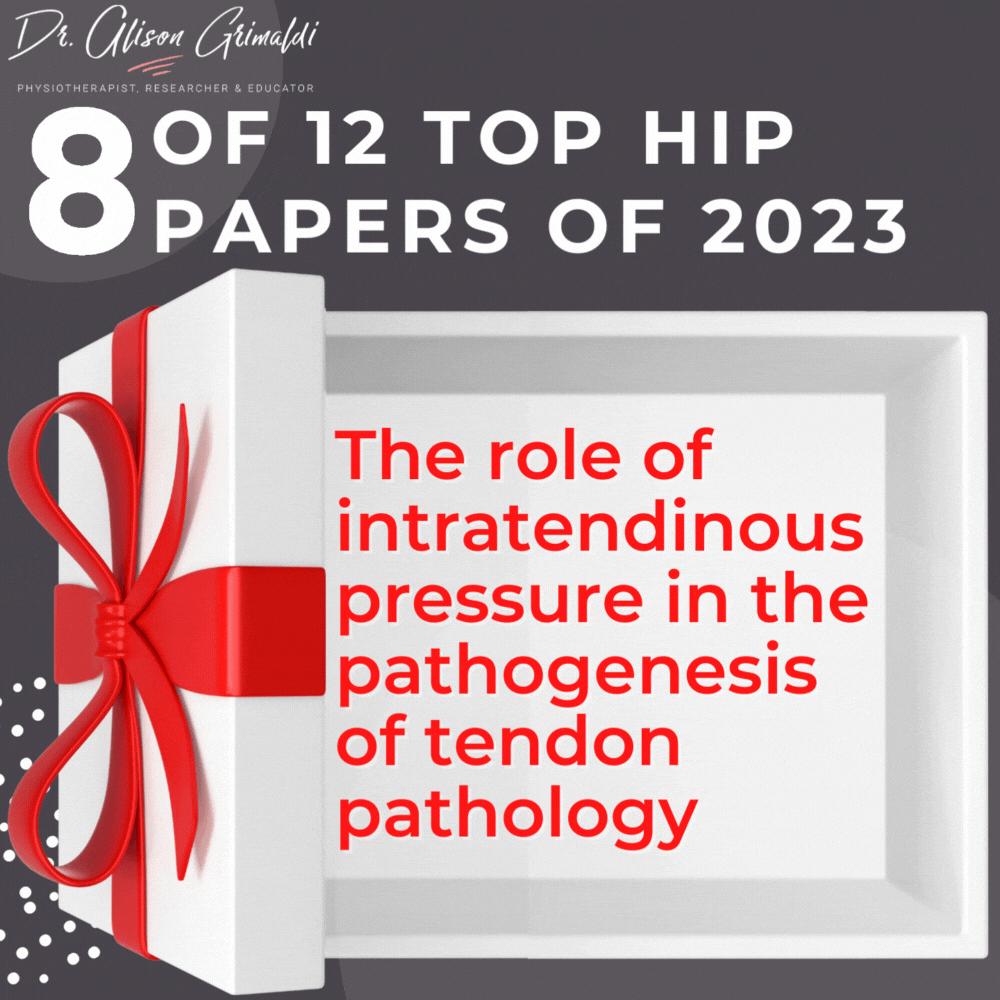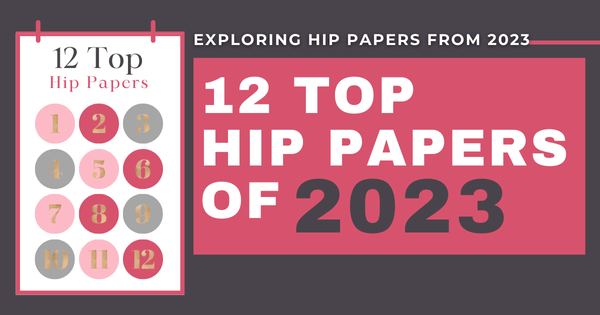7 of 12 Top Hip Papers of 2023 | APTA clinical guidelines for non-arthritic hip joint pain

Today is Day 7 of my 12 Top 2023 hip papers. If you missed Day 6, you'll find a link at the bottom of this page to take you back.
The top hip paper for day 7 is an update of the American Physical Therapy Association Guidelines for assessment and management of hip pain and movement dysfunction associated with non-arthritic hip joint pain.
Can't make the workshop? Do the Online Course

For your convenience, we have also developed this content into a FREE 31-page full colour ebook!
Packed full of 12 Top Hip Papers - peer reviewed scientific papers from 2023, that have contributed to our understanding of hip conditions and/or the assessment or management of hip pain or injury.

7 of 12 Top Hip Papers of 2023 : Hip pain & movement dysfunction associated with non-arthritic hip joint pain1
Physiotherapists and physical therapists regularly treat patients with non-arthritic hip joint pain, often associated with acetabular dyplasia, femoroacetabular impingement, femoral malversion and/or labral pathology. It's important that we try to keep up-to-date with the evidence-base and keep our clinical guidelines reflective of the evidence where possible (ie where the evidence is sufficient). Clinical experts can assist in providing interim guidance where the evidence is currently inadequate.
Study Aim:
The aim of this project was to update the previous 2014 guidelines. The purposes of the clinical guidelines are to:
- Describe evidence-based physical therapy practice for non-arthritic hip joint pain.
- Provide guidance with respect to diagnosis and examination of impairments in this population.
- Provide guidance on evidence-based physical therapy interventions for non-arthritic hip pain.
- Identify appropriate outcome measures to assess changes resulting from physical therapy interventions for non-arthritic hip pain.
What was done:
An update of the 2014 American Physical Therapy Association (APTA) Clinical Guidelines for assessment and management of hip pain and movement dysfunction associated with non-arthritic hip joint pain.
- A systematic search for relevant literature was conducted on studies published since the time of the last review (2013), up until July 2022.
- The authors determined:
- the level of evidence and quality of each article.
- the strength of the evidence and grades of recommendation.
- Recommendations for clinicians treating non-arthritic hip pain were developed and refined after feedback from expert reviewers and public comment.
Key Recommendations:
GRADES OF RECOMMENDATIONS: (see paper for levels of evidence)
S -STRONG M - Moderate W - Weak C - Conflicting T - Theory O - Opinion
1. Diagnosis - Clinical assessment and testing of non-arthritic hip pain
W - FADIR & FABER tests may be used to identify those without FAIS, when these tests are negative.
W - Clinicians may include the ligamentum teres test to identify those with & without a ligamentum teres tear.
2. Examination - outcome measures for non-arthritic hip pain
S - Recommended Patient Rated Outcome Measures (PROMs): iHOT, HAGOS, HOS.
W - Clinicians may also use a PROM for depression, anxiety, low self-efficacy and kinesiophobia.
Clinical Practice Guidelines for Nonarthritic Hip Joint Pain: Weak recommendations for physical diagnostic tests, but strong recommendations for commonly used Patient Rated Outcome Measures: the iHot, HAGOS, and HOS.
3. Examination of physical impairments in non-arthritic hip pain
M - Clinicians should continue to assess hip range-of-motion and strength of hip IR, ER, flexion, extension, abduction and adduction.
4. Examination of activity limitation and physical performance
M - Clinicians should include measures of function and postural control: Single Leg Stance Test; Star Excursion Balance Test, hop distance, single-leg sit to stand, and timed measures of function.
5. Interventions for non-arthritic hip pain - multimodal intervention
M - Clinicians should use multimodal interventions:
-
- activity modifications
- strengthening for hip-specific muscles, trunk and lower limb
- manual therapy
- postural and movement correction
- stretching
- balance exercises
6. Intervention for non-arthritic hip pain - movement pattern training
W - Clinicians may provide movement pattern training to optimize lower limb movement patterns associated with hip pain during activities of daily living
Clinical Practice Guidelines for Nonarthritic Hip Joint Pain: Moderately strong recommendations for use of objective measures of impairments and multimodal treatment approaches. Weak recommendation for movement pattern training.
7. Interventions for non-arthritic hip pain - therapeutic exercise
W - Clinicians may use therapeutic exercises and activities to address individual deficits in joint mobility, muscle flexibility, and muscle strength.
8. Interventions for non-arthritic hip pain - patient education and counseling
W - Clinicians may use patient education and counseling to modify aggravating factors and manage pain associated with FAIS.
9. Interventions for non-arthritic hip pain - Bracing
C - Unable to make recommendations for bracing as a single intervention, based on current evidence.
10. Interventions for non-arthritic hip pain - manual therapy
O - Joint mobilization may be used where capsular restrictions are suspected to be impairing mobility.
Soft tissue mobilization may be used where soft tissue restrictions are suspected to be impairing mobility in those with FAIS.
10. Interventions for non-arthritic hip pain - Neuromuscular re-education
O - Progressive neuromuscular re-education may be used to reduce identified coordination impairments.
Clinical Practice Guidelines for Nonarthritic Hip Joint Pain: Weak recommendation for exercise and patient education, conflicting evidence for bracing, expert opinion only for manual therapy and neuromuscular re-education.
Clinical Implications:
This has been a valuable update and highlights areas where much work is still to be done to strengthen the evidence around useful assessment techniques and interventions.
Not surprisingly, diagnostic tests have been recommended primarily to rule out hip joint related pain when the tests are negative. Combining impingement tests with more specific range-of-motion assessments is advisable.
The most recommended outcomes measures were the iHot, HAGOS and the Hip Outcome Score. The iHot has a 33 item and a 12item version for reduced time burden. The HAGOS is the other most commonly used PROM and has useful subsections to measure different domains, however it is quite long and burdensome for patients to fill out, so I find it is best used at longer intervals.
There was weak evidence for most interventions but evidence was stronger for multi-modal interventions. This is good news as it is generally how most physiotherapists/physical therapists practice.
It's good to know where the evidence is then, but the lack of strength of the evidence highlights how much research is still to be done to improve confidence in receommendations around management of non-arthritic hip pain.
Like to learn more about assessment and management of non-arthritic hip joint pain?
In this course, you can find detailed information on pathoaetiology, assessment and management of non-arthritic hip joint pain and other soft tissue and nerve related conditions. To learn more, take the anterior hip and groin pain online course, or join me in an online or practical anterior hip and groin pain workshop.
This online course is included in Hip Academy and Hip Academy members receive discounts for online workshops.
I hope you enjoyed the key learnings from Day 7 of my 12 Top Hip Papers of 2023. There are 5 more papers in this series, so use the navigational graphics below, to see what other top papers and infographics I have for you!

Have you heard about Hip Academy?
Enjoy the benefits of a world class educational Hip Program, specifically designed by Dr Alison Grimaldi to help improve your knowledge surrounding the Hip and Pelvis, and become an expert in your field.
With all Hip Courses included, enjoy all the extra inclusions, including; access to the entire eBook series, growing video library, expanding PDF resource centre, regular member meetings, forums + lots more!







